| 20th Dynasty (97) 1197-1100BC | |
| How the XXth Dynasty gained power remains unclear. The only indications of the political events at this date derive from a stele erected on the island of Elephantine by its first ruler, Setkhnakht, and an account written down in the Great Harris Papyrus from the biggining of the reign of Ramesses IV. On the stele, Sethnakht relates how he expelled rebels who on their flight left behind the gold, silver, and copper they had stolen from Egypt and with which day had wanted to hire reinforcements among the Asiatics. The papyrus describes how a state of lawlessness and chaos had broken out in Egypt because of forces from 'outside'; after several years in which there was no one who ruled, a Syrian called Iarsu (a made-up name meaning 'one who made himself' ) seized power, and his confederates plundered the country; they treated the gods like ordinary human beings and no longer sacrificed in the temples. From these texts we may perhaps conclude that, after the death of Taweseret, Bay had tried to seize power and may even have succeeded for a brief time until he was expelled by Sethnakht. | |
|
Setnakhte |
|
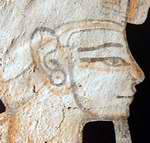 Origin
of Sethnakht is uncertain. Possibly his father was one of Ramesses
II sons, unknown by name brother of Merenptah. He accessed the
throne after death of queen Taweseret. It was the time when anarchy
has set in the land. Sethnakht became famous for usurping numerous
buildings erected by his predecessors. Himself, presumably he
founded two chapels at Deir el-Medina. He died short after he
proclaimed himself king and restored order in Egypt. He was buried
in a tomb (also the usurped one) of queen Taweseret – the tomb KV14
in the Valley of the Kings. The king’s mummy was discovered in KV35
tomb-cache of Amenhotep II. Setnakht was father of Ramesses III.Other
Datings Origin
of Sethnakht is uncertain. Possibly his father was one of Ramesses
II sons, unknown by name brother of Merenptah. He accessed the
throne after death of queen Taweseret. It was the time when anarchy
has set in the land. Sethnakht became famous for usurping numerous
buildings erected by his predecessors. Himself, presumably he
founded two chapels at Deir el-Medina. He died short after he
proclaimed himself king and restored order in Egypt. He was buried
in a tomb (also the usurped one) of queen Taweseret – the tomb KV14
in the Valley of the Kings. The king’s mummy was discovered in KV35
tomb-cache of Amenhotep II. Setnakht was father of Ramesses III.Other
DatingsOther Datings 1200-1198 (Drioton,
Redford) |
|
|
Rameses III |
|
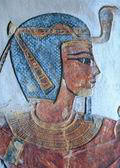 Son
of Sethnakht by Teje-Mereniset. He warred with Libyans in year 5 and
11 of his rule. Rebelling Libyan tribes had been brought into line,
their cattle reinforced donations of the temple of Amun at Karnak
while some of the tribes were displaced presumably to Balkan and
Egeian territories. He made two successful campaigns in Asia where
in both inland and naval battle near outlet of the South Delta he
defeated invaders’ attack and thus saved Egypt from foreign rule.
Captured invaders were included to Egyptian army, some of them
founded in Asia the country of Philistines. Many accounts are
preserved as to building activities of Ramesses III. He erected
among others magnificent mortuary temple with palace at Medinet
Habu, started works at the area of the sacral complex at Karnak.
Also at Edfu, Buhen, Kom Ombo, Koptos, el Kab and many more places
there are numerous monuments built by Ramesses III. In year 32 of
his rule a harem conspiracy was plotted to draw the king aside of
the rule. He was to be replaced by prince Pentewere, the plot was
discovered thank to legal heir – Ramesses IV. The guilty were
sentenced to death or mutilation. Primary burial place of the king
was supposed to be a KV3 tomb in the Valley of the Kings, however
works on it had been cancelled. Ultimately the pharaoh was buried in
annexated tomb of Setnakht – the tomb KV11 in the Kings’ Valley,
while the tomb KV3 was used for burial of one of Ramesses’ sons. The
king’s mummy was found in the DB320 cache at Deir el-Bahari. Son
of Sethnakht by Teje-Mereniset. He warred with Libyans in year 5 and
11 of his rule. Rebelling Libyan tribes had been brought into line,
their cattle reinforced donations of the temple of Amun at Karnak
while some of the tribes were displaced presumably to Balkan and
Egeian territories. He made two successful campaigns in Asia where
in both inland and naval battle near outlet of the South Delta he
defeated invaders’ attack and thus saved Egypt from foreign rule.
Captured invaders were included to Egyptian army, some of them
founded in Asia the country of Philistines. Many accounts are
preserved as to building activities of Ramesses III. He erected
among others magnificent mortuary temple with palace at Medinet
Habu, started works at the area of the sacral complex at Karnak.
Also at Edfu, Buhen, Kom Ombo, Koptos, el Kab and many more places
there are numerous monuments built by Ramesses III. In year 32 of
his rule a harem conspiracy was plotted to draw the king aside of
the rule. He was to be replaced by prince Pentewere, the plot was
discovered thank to legal heir – Ramesses IV. The guilty were
sentenced to death or mutilation. Primary burial place of the king
was supposed to be a KV3 tomb in the Valley of the Kings, however
works on it had been cancelled. Ultimately the pharaoh was buried in
annexated tomb of Setnakht – the tomb KV11 in the Kings’ Valley,
while the tomb KV3 was used for burial of one of Ramesses’ sons. The
king’s mummy was found in the DB320 cache at Deir el-Bahari.Other Datings 1198-1166 (Drioton,
Redford) |
|
|
Rameses IV |
|
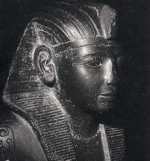 Son
of Ramesses III by queen Iset, brother of Ramesses VI.His definite
standpoint against the harem plot by the end of his father’s rule
assured him succession to the throne. There are found numerous
traces of works in quarries at Wadi Hammamat and mines in Sinai in
his times. Burial place of Ramesses was a tomb KV2 in the Kings’
Valley although, yet being a prince, he started building of a tomb
in the Valley of the Queens – QV53. Ramesses died aged 50. Mummy of
the king was discovered in the KV35 tomb-cache of Amenhotep II. Son
of Ramesses III by queen Iset, brother of Ramesses VI.His definite
standpoint against the harem plot by the end of his father’s rule
assured him succession to the throne. There are found numerous
traces of works in quarries at Wadi Hammamat and mines in Sinai in
his times. Burial place of Ramesses was a tomb KV2 in the Kings’
Valley although, yet being a prince, he started building of a tomb
in the Valley of the Queens – QV53. Ramesses died aged 50. Mummy of
the king was discovered in the KV35 tomb-cache of Amenhotep II.Other Datings 1166-1160 (Redford) |
|
|
Rameses V |
|
|
Son of Ramesses IV by queen Tentipet. Scanty artifacts survived from
his times at Heliopolis, Karnak, Deir el-Bahari and Sinai. Most
significant written document dated to that period is the Wilbour
papyrus. This is one of most important sources of evidence
concerning Egyptian economy at those times. The king died of
smallpox aged 30-odd. Burial place – tomb KV9 in the Valley of the
Kings, shared with Ramesses VI. The king’s mummy was discovered in
the tomb-cache of Amenhotep II – KV35. Other Datings 1160-1156 (Redford) |
|
|
Rameses VI |
|
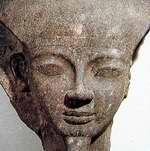 Son
of Ramesses III by queen Iset, brother of Ramesses IV. Apart from
numerous monuments usurped by Ramesses, other artifacts are located
at Memmphis (pylon and part of a colossal statue), Heliopolis,
Karnak (stelae) and Sinai. Statues of Ramesses are found at Tanis,
Bubastis, Koptos. Burial place – finely decorated, shared with
Ramesses V tomb KV9 in the Kings’ Valley. Mummy of the king was
discovered in the KV35 tomb-cache of Amenhotep II. Son
of Ramesses III by queen Iset, brother of Ramesses IV. Apart from
numerous monuments usurped by Ramesses, other artifacts are located
at Memmphis (pylon and part of a colossal statue), Heliopolis,
Karnak (stelae) and Sinai. Statues of Ramesses are found at Tanis,
Bubastis, Koptos. Burial place – finely decorated, shared with
Ramesses V tomb KV9 in the Kings’ Valley. Mummy of the king was
discovered in the KV35 tomb-cache of Amenhotep II.
Other Datings 1156-1149 (Redford) |
|
|
Rameses IX |
|
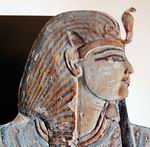 Descent
of this ruler is not well established. Presumably he was son of
Montuherchopshaf, who in turn was son of Ramesses III by Takhat.
However E.F. Wente states that Ramesses IX was son of Ramesses VIII,
while according to one of the K. Kitchen’s hypotheses his father was
Ramesses VII. Additionally some scholars believe that he was son of
Ramesses III and a queen of unknown name, he could also be a broter
of Ramesses VIII. Duration of reign of Ramesses IX was famous for
interrogations of tomb robbers in the Kings’ Valley and against
bossing corruption of officials. Burial place – tomb KV6 in the
Valley of the Kings. Mummy of the king was discovered in the DB320
cache at Deir el-Bahari. Descent
of this ruler is not well established. Presumably he was son of
Montuherchopshaf, who in turn was son of Ramesses III by Takhat.
However E.F. Wente states that Ramesses IX was son of Ramesses VIII,
while according to one of the K. Kitchen’s hypotheses his father was
Ramesses VII. Additionally some scholars believe that he was son of
Ramesses III and a queen of unknown name, he could also be a broter
of Ramesses VIII. Duration of reign of Ramesses IX was famous for
interrogations of tomb robbers in the Kings’ Valley and against
bossing corruption of officials. Burial place – tomb KV6 in the
Valley of the Kings. Mummy of the king was discovered in the DB320
cache at Deir el-Bahari.Other Datings 1139-1120 (Redford) |
|
|
Rameses X |
|
|
Nine years long reign assigned to this ruler by some scholars seems
not very possible. The last known document evidencing rule of
Ramesses X refers to year 3, as mentioned in records of necropolis
of Deir el-Medina. Burial place – tomb KV18 in the Valley of the
Kings. Neither mummy nor any item from his funerary equipment has
been found. Other Datings 1120-1111 (Redford) |
|
|
Rameses XI |
|
|
Son of Ramesses X and queen Titi. Reign of Ramesses XI was marked by
collapse of the national authority, economical crisis, robberies of
the royal tombs, famine and, finally, civil war. Into times of
Ramesses XI fall controversial episode of expedition of Panehesi to
the south, aiming to put into order that part of the land. Ambitions
of the general Panehesi resulted in conflicts with Amenhotep – the
high priest of Amun at Thebes. The civil war had begun. At
Amenhotep’s request Ramesses XI had sent additional units of army
commanded by Piankhi who drove Panechesi out of the land whilst
Piankhi himself, followed by his son-in-law Herhor (maybe
inversely…?) overtook a post of high priests still warring in Nubia
for next 10. By the end of Ramesses rule Smendes reigned in the
North (presumably he was vizier of that territory), Herhor rules at
Thebaida and gives rise to a powerful and independent of the central
rule at Tanis dynasty of High Priests of Theban Amun. Ramesses XI
was buried in the KV4 tomb in the Kings’ Valley. Other Datings 1114-1087 (Gardiner) |
|